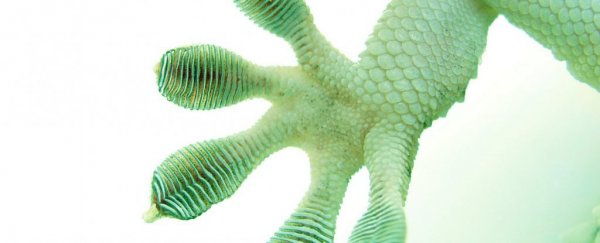Inspired by the incredible nanostructures that make geckos' feet stick to walls, scientists have developed a new technique that allows them to laser-print objects that have complex and responsive properties.
This opens up the possibility to quickly and cheaply create materials that could greatly benefit science, technology and industry. Imagine materials that trap and release certain particles; self-cleaning objects; and super-adhesive structures.
Scientists know that these properties can all come from the complex layout of nano-pillars on the surface of an object, which control the way substances flow around them. But right now, they have to etch these surface features individually onto objects, which is time-consuming and expensive.
However, nature has a better way of doing it, known as 'self-assembly', which gives animals such as the gecko and plants like the hydrophobic salvinia leaf multi-functional nano-structures, and for decades scientists have been trying to mimic this ability.
Now researchers from Swinburne University of Technology in Australia and the University of Science and Technology in China have combined laser printing and something called 'capillary force' to find a way to quickly print structures with these self-assembling abilities.
Capillary force refers to the tendency for a liquid to rise up into narrow tubes or be drawn into small openings, and by changing the surface structure of a material, the researchers have found they can control this force.
"Using laser printing techniques we can control the size, geometry, elasticity and distance between tiny pillars - narrower than the width of a human hair - to get the self-assembly that we want," lead author of the study, Yaniel Hu from Swinburne University of Technology, said in a press release.
Using ultrafast laser printing, the researchers are able to produce an array of tiny pillars of varying heights. They then wash their material in a development solvent - a process similar to developing a photograph in a dark room - and as a result of the gravity-governed capillary force, this produces pillars of unequal physical properties along different axes.
"A possible application of these structures is in on-chip micro-object trap-release systems which are in demand in chemical analysis and biomedical devices," said team member Ben Cumming.
The team have already shown that materials made using the new technique, which they're calling laser printing capillary-assisted self-assembly (LPCS) can selectively capture and release micro-particles, and it's much simpler and more practical than current etching methods. "Moreover, the assembled cells can be used as automatic micro-grippers for selective trapping and controllable releasing, suggesting many potential applications in the field of chemistry, biomedicine and micro-fluidic engineering," one of the researchers, Min Gu, said in the release.
This is pretty proof-of-concept stuff, but if researchers can use this technique to print more self-assembly nanostructures onto materials, the potential could be pretty huge. It could make the production of hydrophobic materials like this one way cheaper, and could make it easier for researchers to quickly produce these super-efficient black silicon solar cells. We're pretty excited to see what scientists do with this next.
The research has been published in the Proceedings of the National Academy of Science.
Love science? Find out more about the world-leading technology being developed at Swinburne.
